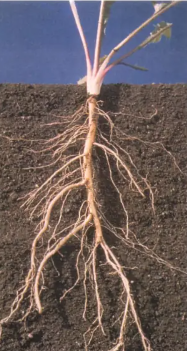Plant organs can be divided into vegetative organs and reproductive organs. Vegetative organs usually refer to the roots, stems, leaves and other organs of plants, while reproductive organs are flowers, fruits, seeds, etc. The basic function of vegetative organs is to maintain plant life, and these functions include photosynthesis, etc. However, under certain conditions, there may be asexual reproduction/vegetative reproduction, which means that these vegetative organs may become the parents of reproduction, and new individuals grow from these organs.
Composition of the roots of plants (2 photos) According to the location of occurrence, roots are divided into three types: taproot, lateral root and adventitious root. The sum of all the roots in the underground part of the plant is called the root system, which is divided into two types: taproot system and fibrous root system. The part from the top of the root to the root hair is called the root tip, which is the most active part of root growth, differentiation and absorption. From the top of the root tip, it is divided into four parts: root cap, meristem (growth point), elongation zone and mature zone (root hair zone).

The initial structure of the root is divided from the outside inwards into the epidermis, cortex, and vascular cylinder (stele). The innermost layer of cells in the cortex is called the endodermis, and on the radial and transverse walls of these cells, there is a band-like thickening structure called the Casparian strip, which plays a role in enhancing the control of substance transfer in roots. The vascular cylinder consists of the pith, primary xylem, and primary phloem. The roots of dicotyledonous plants can undergo secondary growth, with the cells of the cambium undergoing cell division to form secondary xylem inwardly and secondary phloem outwardly. The physiological functions of roots include absorption, support, synthesis, and storage, and plant roots also have a role in nutrient reproduction.
The stem’s morphological features include nodes and internodes, buds, and leaf scars on the nodes after leaf fall. Depending on their growth habits, stems can be classified into four types: erect stems, climbing stems, twining stems, and prostrate stems. The main stem of the stem develops from the embryo of the seed, and the lateral branches develop from buds on the main stem. Therefore, the bud is a prototype of a branch. When longitudinally sectioning a plant’s leaf bud from top to bottom, it consists of the growing point, leaf primordium, young leaf, and axillary bud primordium in sequence.
The primary structure of the stem of dicotyledonous plants is divided into epidermis, cortex, and vascular cylinder. The vascular cylinder consists of vascular bundles, pith, and medullary rays. The vascular bundle is a bundle-like structure composed of primary phloem, cambium, and primary xylem. The vascular bundles in the stem of dicotyledonous plants are often arranged cylindrically. The secondary structure of the stem is the portion that thickens due to the activity of the cambium. The activity of the cambium is influenced by the seasonal climate, resulting in the formation of annual rings in the cross-section of perennial woody stems. Generally, the stems of monocotyledonous plants only have a primary structure, consisting of epidermis, vascular bundles, and parenchyma tissue. Beneath the epidermis, there is mechanical tissue that provides support, with cells often containing chloroplasts. The vascular bundles are scattered, and in some plant stems, there is a hollow medullary cavity.
The physiological functions of the stem mainly involve transporting water, inorganic salts, and organic nutrients, while also providing support for stems, leaves, flowers, and fruits to grow upwards. Additionally, stems have roles in storage and nutrient reproduction.

The leaf of a plant generally consists of three parts: the leaf blade, the petiole, and the stipule. The leaf blade contains leaf veins, which can be classified as either reticulate or parallel veins. The petiole provides support and transportation. The structure of the leaf blade typically consists of three layers: the epidermis, mesophyll, and veins. The epidermis is divided into upper and lower epidermis. There are numerous stomata between the epidermal cells, surrounded by two guard cells, which control the opening and closing of stomata. Stomata serve as pathways for transpiration of water and exchange of gases. The mesophyll is composed of thin-walled cells containing numerous chloroplasts and is divided into palisade and spongy tissues. Large and medium-sized leaf veins consist of vascular bundles and mechanical tissues, with xylem on top and phloem below. The finer the leaf vein, the simpler the structure.

The tissues between the various organs of a plant are interconnected. Although the structures of roots, stems, and leaves differ, the dermal tissue system, vascular tissue system, and ground tissue system of each organ are continuous. They collectively constitute the unified whole of the plant body. The connection between the dermal tissue and the ground tissue system is relatively simple, while the connection of the vascular tissue is more complex.
The morphological variations of plants include modified roots such as storage roots (fleshy taproots, tuberous roots), aerial roots (prop roots, pneumatophores, clinging roots), and parasitic roots (haustoria); modified stems include underground stem modifications (rhizomes, bulbs, corms, stolons) and aboveground stem modifications (tendrils, thorns, cladophylls, succulent stems); modified leaves include bracts, tendrils, scales, spines, and insect-trapping leaves.
